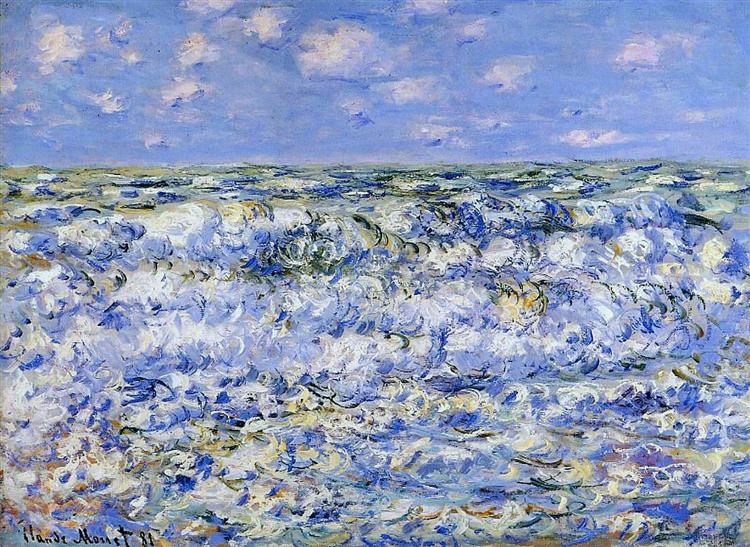Beschrijving
Claude Monet's "Waves Crashing" (1881) is a brilliant example of the artist's innovative approach to depicting landscape and nature. Capturing the force and movement of the ocean, this painting reflects Monet's interest in the changing conditions of light and color, as well as his ability to translate sensory experience into a visual image.
The composition of the work is dominated by the depiction of the sea in a state of agitation. The waves, painted with a loose and rapid brushstroke technique, seem to come to life, defying the stillness of the beach. The bold use of light and shadow lends an inherent dynamism to the scene, while the choice of colours, with a predominance of blue and grey tones, suggests a cloudy day, typical of the French coast that Monet frequented. The touches of white that outline the crests of the waves provide a vibrant contrast, emanating a sense of energy and vitality that invites the viewer to feel the movement of the water.
There are no human figures to be seen in this work, allowing the viewer to become fully immersed in the majesty of the seascape. This approach aligns with Monet's impressionist style, which often prioritized nature over the human figure, focusing on visual and atmospheric aspects of the environment. By abstracting the human presence, Monet also emphasizes the grandeur of nature, reminding us of its power and beauty.
Monet’s study of water and its ability to capture light is evident in every brushstroke. The work evokes not only the sight of the sea, but also the sensory experience of standing in front of it: the sounds of the crashing waves, the sea breeze and the salt air. Monet was dedicated to capturing these sensations, using his signature technique that breaks down colour into separate touches, offering a vibrant surface that allows light to play and reverberate.
The historical context of "Waves Crashing" is significant in the career of Monet, who by this time was already recognized as one of the pioneers of Impressionism. During the 1880s, Monet expanded his interest in capturing natural light and color, experimenting with different times of day and weather conditions. This work marks a period in which the artist focused intensively on the effects of water. Contemporary works such as "Impression, Sunrise" and his series on water lilies show his stylistic evolution and his dedication to the themes for which he became famous.
In conclusion, "Waves Crashing" not only represents a visual and emotional analysis of the sea, but also encapsulates Monet's constant quest to capture the essence of the natural world. Its technical mastery and deep connection with nature place this work in a privileged place within the canon of Impressionism and art history in general, reminding us of the ephemeral beauty and power of the ocean.
KUADROS ©, a famous painting on your wall.
Hand-made oil painting reproductions, with the quality of professional artists and the distinctive seal of KUADROS ©.
Painting reproduction service with satisfaction guarantee. If you are not completely satisfied with the replica of your painting, we will refund 100% of your money.

